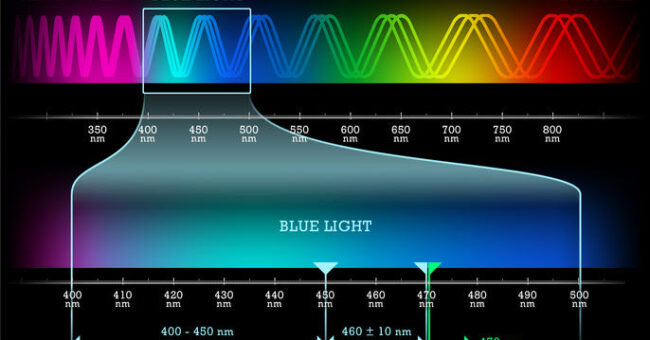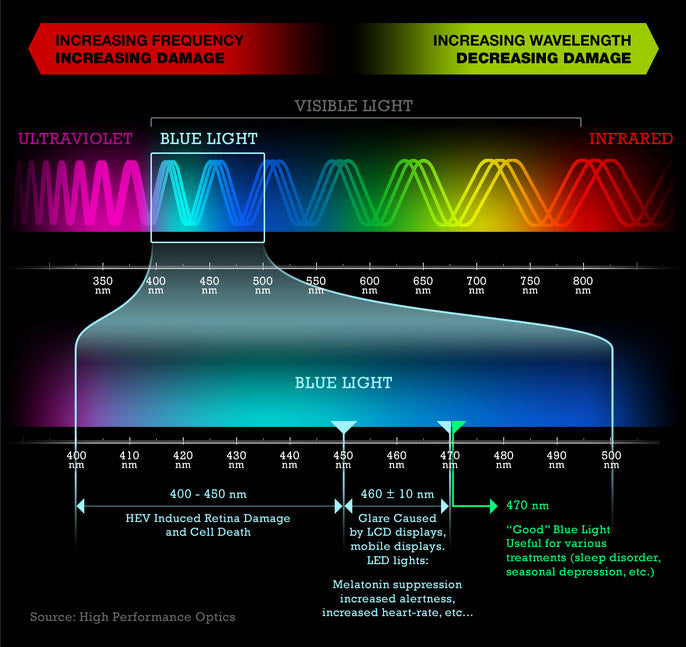
Blue Light

Blocking blue light in sunglasses is important because it can help protect eyes from potential long-term damage, reduce eye strain, and improve overall visual comfort. Blue light, a higher-frequency light from the sun and electronic devices, can contribute to eye fatigue, headaches, and even potentially cause retinal damage over time.
Blue light lenses have been modified by placing a special filter or a coating to block blue light from reaching the eyes.
The discovery that blue light is a problem for our eyes came from research conducted by NASA’s Jet Propulsion Laboratory (JPL) where scientists developed ground-breaking technology that would protect human eyesight from the harmful effects of solar radiation light.
NASA’s scientists first looked to nature for a solution – in particular, by studying eagles and hawks who can distinguish their prey from their surroundings with utmost precision.
They discovered that the eagles have unique oil droplets in their eyes that selectively filter out harmful solar radiation and only permit specific wavelengths of light to reach their eyes giving them extremely powerful visual clarity, even at a great distance.
The first use of this technology occurred when Eagle Eyes Freedom Non-Polarized lens sunglasses were developed to protect the eyes of our first astronauts. They were so successful that Eagle Eyes decided to make their incredible sunglasses availble to the general public.
For example, take a look at this video showing an eagle grabbing a fish which it could see even below the water’s surface!
NASA then replicated this discovery into a lens technology that in turn was developed by Eagle Eyes®. Eagle Eyes® then became a leader in high performance eyewear like those offered by Eagle Eyes®.
Eagle Eyes® technology involves placing a filter in the lens which works by blocking out 99.9% of ultraviolet rays and harmful blue and violet light rays while at the same time allowing in vision-enhancing light rays (green, yellow, orange, and red) within the safe nanometer range of the wavelength light spectrum. This technology allows you to see images more vividly with better contrast and definition.
Here’s a more detailed look at why blue light blocking is important:
Reduced eye strain:
Blue light can cause eye strain, headaches, and dry eyes.
Blue light blocking can enhance visual clarity and reduce the sensation of looking at screens for extended periods.
Potential long-term eye health:
University of California – Davis Health notes that excessive blue light exposure could lead to retinal damage and vision problems like age-related macular degeneration.
Blue light suppresses the production of melatonin, a hormone that regulates sleep, potentially leading to sleep problems. It is also a tool that can be used to combat seasonal depression and insomnia.
Enhanced color perception and contrast:
Blue light can also affect color perception and contrast, and blocking it can improve these aspects.
Protection from glare:
Sunglasses, especially those with polarized lenses, can reduce glare and improve visibility in bright conditions, including blue light.
While UV protection remains crucial for overall eye health, blue light blocking in sunglasses can offer additional benefits, particularly for those who spend significant time outdoors or with electronic devices.
I hope you enjoyed this trip through some of the history of aviation. If you enjoyed this trip, and if you are new to this newsletter, sign up to receive your own weekly newsletter here: Subscribe here!
Until next time, keep your eyes safe and focused on what’s ahead of you, Hersch!



